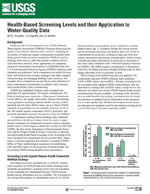To supplement existing Federal drinking-water standards and guidelines, thereby providing a basis for a more comprehensive evaluation of contaminant-occurrence data in a human-health context, USGS began a collaborative project in 1998 with USEPA, the New Jersey Department of Environmental Protection, and the Oregon Health & Science University to calculate non-enforceable health-based screening levels. Screening levels were calculated for contaminants that do not have Maximum Contaminant Level values using a consensus approach that entailed (1) standard USEPA Office of Water methodologies (equations) for establishing Lifetime Health Advisory (LHA) and Risk-Specific Dose (RSD) values for the protection of human health, and (2) existing USEPA human-health toxicity information.


